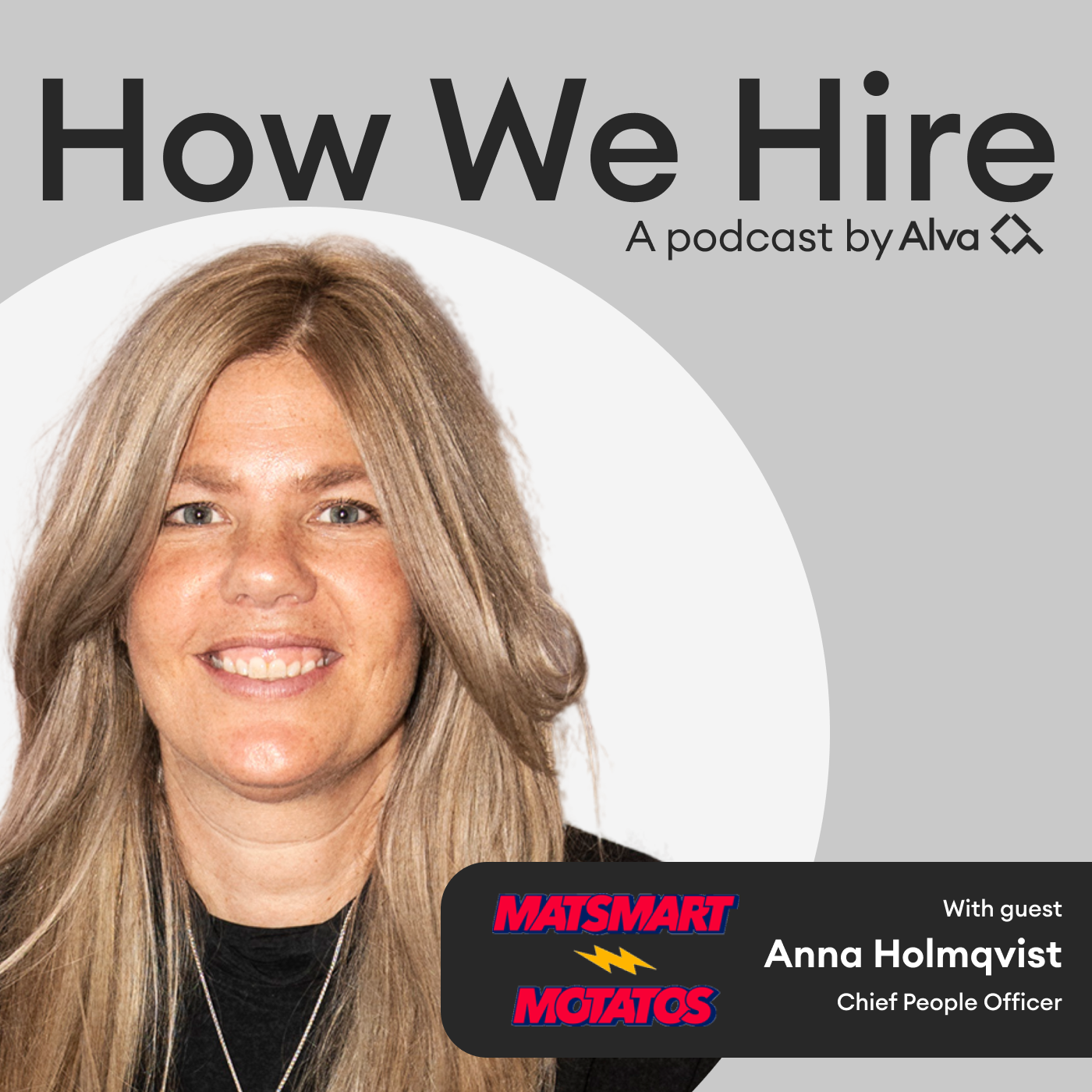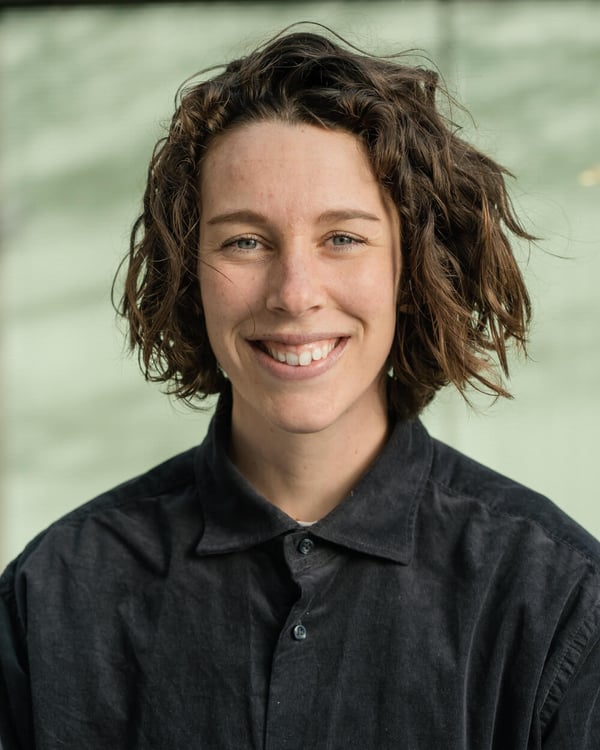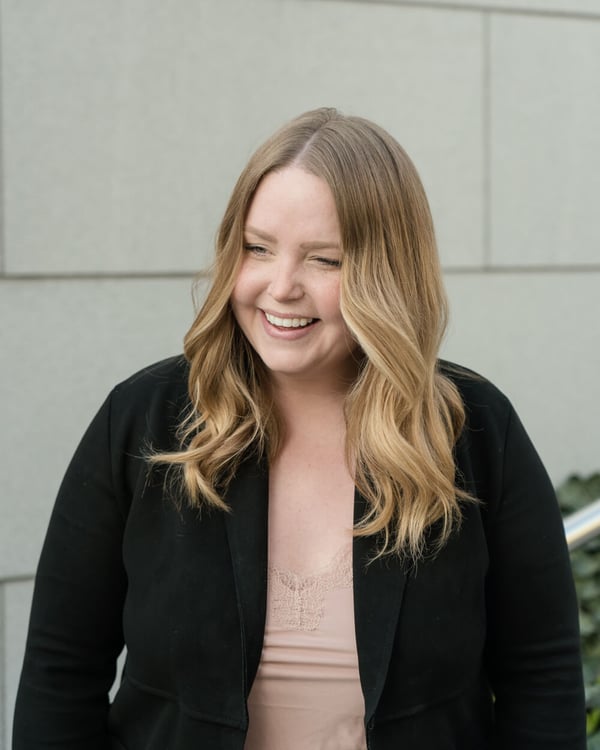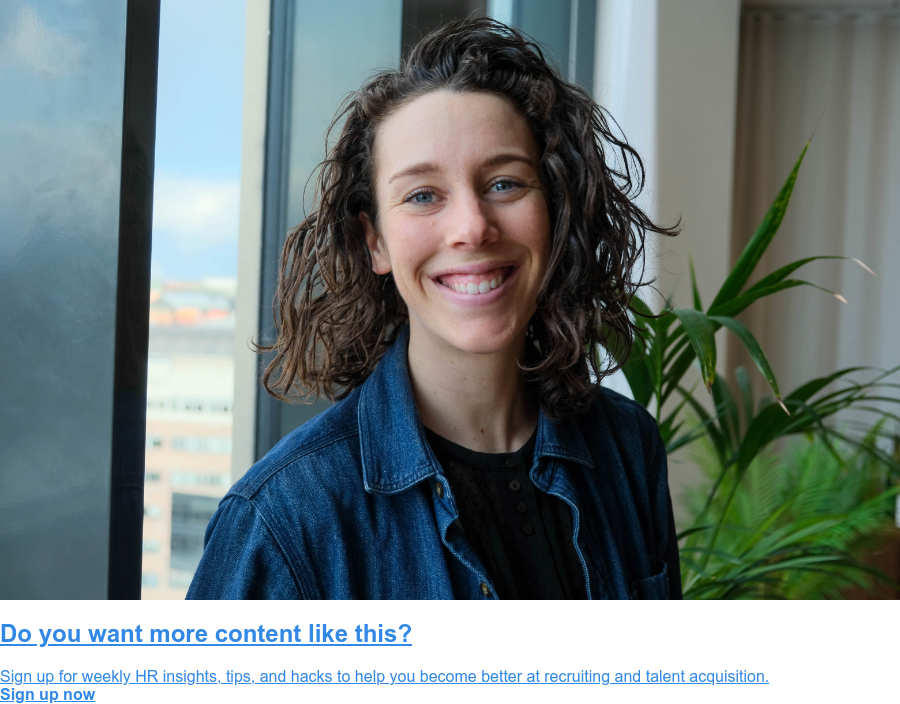How We Hire: Episode three transcript
Tove Hernlund: Hi, and welcome to another episode of How We Hire with me, Tove, and Linnea of course, is here as well. But today, we have a guest with us, Anna Holmqvist, can you please tell us a little bit about yourself?
Anna Holmqvist: Yeah. My name is Anna. I've been working with HR and people for, I would say, a little bit more than 15 years. But I love what I do. I love to work with enable or releasing potential in both business, organization and people. I think that's a brilliant combination. I think I've been given the opportunity to see a lot. I think I have a quite spread with the industries I've been in. So I've been in tech, I've been in finance, I've been in telecom, in retail and now e-com.
So I think that has given me pretty broad toolbox, but always with the focus or the talent side. And now, I am chief people at Matsmart Motatos since a month ago. So joining, getting ready to take the next big step in our journey here.
Tove Hernlund: Super exciting. And the journey that you're on with Motatos or Matsmart is super exciting for a lot of reasons. You're saving the world in some sense, right? Tell us a little bit about what's accompanied us, just so that everybody has a little bit of a view on that.
Anna Holmqvist: Yeah. So we call ourself a different kind of food store. The business model is really about saving food that otherwise would get wasted. And that's a huge problem for the environment and in order for us to reach the climate goals, so that's what we do. And then we sell it on our own platform for a very good price. You can also save a little bit, not only save the planet, but also save your wallet.
So super proud to be able to work at a company that does something good. And I think also, to make sustainable choices for everyone. I think in a lot of industries, you need to pay more to do the smart choice. And I think this is something that we actually can offer to everyone to do a smart choice.
Tove Hernlund: And in terms of, the different industries you've been in, you've been in large corporations like H&M, you've been in the tech industry, as you said, and start-up world, scale-up world. Would you say the way you've worked within recruitment and just people in general, have that been widely different or do you see that there's been clear similarities of, "Okay, but all of my organizations that I've worked for have still done things pretty much the same way or have the same challenges."
Anna Holmqvist: I think if we focus on recruitment, I would actually say that the challenge are pretty similar. I think the hardest part is, how do you find the time to invest to do a really good job before you start, so you know what you're looking for? Same problem, no matter where you are. Or how do you fight the bias and make people to understand that? And use the tools and not fast forward the process because you're stressed. And the stress of not having the person in place and how that impacts your recruiting. I think those big challenges, they are the same no matter where you work.
Linnea Bywall: I think that's really interesting. And just diving into, because I think one of the, to some extent, biggest challenges might not be that you don't have the knowhow or the processes or stuff like that within your TA team. But the biggest challenge is when you need to involve the hiring manager and they have such different demands. What's your tricks up your sleeves to make that work well?
Anna Holmqvist: I think making outspoken expectations on their managers. Part of your job is to find and grow talent, so that is clear and you cannot become high performing managers if you don't invest time in finding talent.
Linnea Bywall: Yeah.
Anna Holmqvist: I think that's important, if that's the strategy you have as a company. But if you believe in that, that should be clear. And then I think we put a lot of effort in the partnership. So we don't end up in supply and demand like, "Okay, I'm the manager and I put a order into TA and then I wait for the product." So more like from the beginning, we're doing this together, you need my help, I need your help. And I put a lot of power in that. And then I believe a lot in keeping it as simple as possible, the things that we actually do that fronts the organization, always think user-friendly and user-experience. So it's not super good for us in the TA team.
Linnea Bywall: Yeah.
Anna Holmqvist: But no one else wants to work in it, so really, really use that. Kind of like, who is the user of the things that I offer?
Linnea Bywall: Yeah. And I think we try to do the same thing, as you said, setting super clear expectations, but then reality always happens. I'm sure it's the same in your organizations, that I'm super committed to doing this process and then all of a sudden I don't have the time. Because we've tried different strategies, but we always do Friday check-ins and summaries of what's happened during the week, so everyone's up to date. But sometimes you need to be super speedy to not lose a candidate. How have you handled that?
Anna Holmqvist: I think one thing that we haven't started yet, but we're going to test, is to have almost a recruitment team out in the organizations. Like for tech, who could be part of the recruitment process, so the higher end [inaudible 00:05:52] don't always get to be the bottleneck?
Linnea Bywall: Nice.
Anna Holmqvist: Train them, we get you on this part of the equipment process. So I'm really keen to see if that plays out well because I think then people get like, "Wow, I get to develop. I get to learn new stuff. I get a new responsibility." I think that's a positive thing in the organization. And the hiring managers can use their time in different steps in the recruitment process. I think that's one good thing. And then of course, from the TA teams, how can we optimize as much as possible? Of course. But I think I'm going to test that one, so that's cool.
Linnea Bywall: Super exciting.
Anna Holmqvist: Yeah.
Linnea Bywall: And you need to come back and tell us how it went. Because I think we'd done, not that, but a version I guess. Because we also have hiring teams and we try to involve people that are not just a manager to review cases, or for example, tests and do interviews and stuff like that. But sometimes when it comes to, okay, the decision needs to be made now. Someone else is pulling that candidate. And I think if you can manage to distribute that decision making, that would be super interesting.
Tove Hernlund: Yeah.
Linnea Bywall: Yeah. To be continued.
Anna Holmqvist: Yeah. To be continued for sure.
Linnea Bywall: How many are you right now, Anna, at Motatos?
Anna Holmqvist: I think we are closer to 230. We're going to launch in UK soon, so a small there. We are in Germany, we are in Finland, Denmark and Sweden. And in Sweden, we have our own warehouse for the Nordic as well.
Linnea Bywall: We're also in that phase of opening up new offices. How, or maybe this was a little bit before your time, but share what you know. What was your strategy to, who do we hire? Where do we put feet on the ground? What types of roles?
Anna Holmqvist: I think that's one of the biggest learning from launching in Germany and taking that into the UK that, of course, we have lots of smart people who has launched in the Nordics before Germany, but that lack of feet on the ground.
Linnea Bywall: Right.
Anna Holmqvist: So I think UK, we staffed up the team before we got started, so we have someone to hold it together, we have a sourcing person on the ground because it's closer to partners. We have marketing on the ground. So we have a small team. A brilliant, I'm so proud of the competence that we have of insisting in the UK. But I think that's one of the biggest learning, we need to have feets on the ground, we need to stay close to partners and to the customers. And I also think, how to be able to scale fast. I think to hire someone, to have someone there that actually you can meet and you can come to the office and see it does exist, this company. I think that will scale faster and be more attractive.
Linnea Bywall: So it sounds like you did sales marketing, and to some extent, TA on the ground before you actually started officially.
Anna Holmqvist: Yeah.
Linnea Bywall: Interesting.
Tove Hernlund: And was that something then that, given the Nordics, going back, and yes, you weren't in place then, but the strategy was a different in the Nordics than it was for Germany and the UK, now that you're thinking back to it?
Anna Holmqvist: Yeah, I think in the Nordics do have a lot of function where we actually can see... That you can use for all the markets because Sweden is the biggest market, but still, we have a customer base that's similar, so we have more functions that actually can be here in Stockholm that has a office that we can use for all countries.
So I think for us, that was a big step going into Germany because it's such a different market and it's so big and it's got so much potential and the UK is the same. So I think here we have to also take the learnings, but also understand that we're doing something new with disrupting the food industry now in Germany and that's huge. So I think also we have to bring in the learnings, but also be brave and start going back to that test phase again.
Linnea Bywall: Within a startup, to some extent.
Anna Holmqvist: Yeah. A little bit.
Tove Hernlund: That is fascinating. In terms of recruitment, yes, recruiting certain people to start in the different markets. But have you recruited locally or has it more been, you've moved people from other offices to start on the ground?
Anna Holmqvist: No, we actually hired locally because I think that's that part of us, growing into a global company, I think that's one of the biggest things I take with me from working in larger companies. How can we be smart already now to not become like, we're the head office in Stockholm, and then we have the small local offices and they're out there. And we start to build different companies. How do you build a truly global organization?
I think it's something that we have to, in all the decisions that we make now, okay, do we think globally or do we think Swedish? I think that was one of the things that we need to hire locally, but then I see great opportunities being a global company, is that if people want to work in different countries, we might be able to make that happen in the future. But I think for now, we need more diversity, so let's use that opportunity that we are in new countries and find people there.
Linnea Bywall: How would you say the recruitment process would differ from the different markets if you have a well known brand that you do in Sweden, compared to I guess a not so well known brand in new markets? How do you work differently?
Anna Holmqvist: Yeah, of course it has been a lot of networking in the new markets where we don't exist. So a lot from people we know, or the first person with feets on the ground, or using our brilliant investors and [inaudible 00:11:49] who knows someone. So I think that has been one. And then a lot more research. I think that has been one of the tricks. But then if you get that in there as well, I think that's one of the things to maybe get the manager more involved as well. If you learn that, okay, it's my responsibility to use my network. You already have them in there.
Linnea Bywall: That's really nice.
Tove Hernlund: Yeah.
Linnea Bywall: I'm super curious, roughly speaking, what does your process look like?
Anna Holmqvist: We're actually just creating it, to be honest.
Tove Hernlund: Super. That's great. I love when it's in the starting point.
Anna Holmqvist: Really good tools, of course, and great people. But we're actually looking into, what are the phases that we want to go through? How can we get strong and with high quality, but still agile? So we're about to launch it, but we have based it on to change the mindset to, how do I collect data to make the most informed decision? So the basic is like, how do we avoid the gut feeling thing? How do we do that? So we have the steps with tests, we have cases, one more culture personality interview, and then more skill sets interview.
And we have one step with a little bit more and meeting with the team. [inaudible 00:13:13]. So I think in general, a pretty basic, but a good process. One good thing that we're doing, is that we're removing references from the data input.
Linnea Bywall: Because we don't use references either, what was your main reason for removing that or that you will remove it?
Anna Holmqvist: Yeah. It was my brilliant TA team who said, "Why do we take that?" We focus a lot on references and we focus a lot on the later part in the process, you know what I mean? Past experience, references, we've so much in the beginning.
And we wanted to switch that over. And I haven't really thought about it. I understand somewhat that references is super subjective and a bit of almost a play in the process like, you call me, I say this, you know that I'm going to say this and so on. But when we really talked about it it's like, it's fine. If a manager wants to call in references to learn something in the coaching, but it's not data that we use in the decision making.
Tove Hernlund: That also sounds like a good middle ground because what usually happens is, if the TA team is really forward thinking, they might want to remove references, but then managers fight back because they're so used to doing that. But by minimizing the weight of it, at least they get the security of still being able to call a reference if they want to, but without it weighing into the decision. That's a genius move I would say.
Anna Holmqvist: Yeah. Let's agree it's not fact.
Tove Hernlund: Yeah. Have you noticed any differences when you've recruited in different markets on this? Because I know in Sweden, reference checking is changing a lot. So the way we do it changes, a lot of organizations are challenging if you should do it or not. But have you noticed a difference in, for example, Germany or the UK?
Anna Holmqvist: To be fair, I wouldn't say that I know, so I'm going to come back in that one as well. But I do think that this mindset of collecting data to make a good decision, I think that's where most countries are moving into.
Linnea Bywall: I would agree. I think, in my opinion, mind, thoughts, I think the way that hiring has been done has been a lot of, you check a CV, you see if that person is similar to yourself, you do a couple of interviews. Or back in the days, if you were forward leaning in recruitment, you did a lot of interviews. So you met several people of the team, and everyone had a say, and then you did some references, and maybe a case, and maybe threw in some tests at the end when you already knew who you wanted.
Which I think you had so many steps because it was also more the employer's market, so there were more candidates available for job openings. So you could waste the candidates time for you to gather as much information as possible.
Linnea Bywall: But no one really questioned, am I gathering new information in each step? Or am I just not wanting to make a decision on my own, but rather have someone else to take a bullet for it if it's the wrong hire. Or I think we are, to some extent, more aware now of, okay, different methods will help in different ways, but also that we need to be way more careful about our own time, and especially the candidate's time. So every method or every step of the process really needs to count, I guess. So I would echo.
Tove Hernlund: And collecting data in every step sounds like a really, really good approach to also make sure there's alignment across the organization. And as you said, with hiring managers, but also within the TA team. What is the actual purpose of us doing this, is to gather this specific data point and then we can use it in this specific way. Being new in your role as well or a month back, is this one of those parts that you're most excited about in the journey that you're now beginning? Or is it something completely else that's also like, yes, this is super exciting?
Anna Holmqvist: I have my dream job, so I'm super excited about everything. But we're coming into phase now where also I think managers, but I would say most employees want to learn new stuff, so I feel no resistance, you know what I mean? I think we're going to end up there because it will be the prioritization of time. But for now, I have the sense that we are like, yes, we want to try new things. We want to do this. I think I'm very excited about that. Since this is my second scaling journey, I think I have a couple of building blocks within the people area that I want to put in place because I think that will help us scale and run so much faster. I think the TA and the processes and the tools around that is key because we're a group.
Anna Holmqvist: I think can we take better decisions faster, that will help us so much growing. But I do think that we also have to focus on, it's not only how many people we can get in and sign a contract, but also how do we get them up and running? So start measuring and looking into that part is like, okay, manager, you might be able to hire five people. I put my time off, I know this is the time I need to put the interviews and like, yes, but do we have the time to make sure they're up and running and can actually start to deliver stuff? But if you don't want that time, we don't need to hire five people, just save it like that and wait.
So I think to also continue to build on that and then take care of other people who has been here maybe for three years, make sure that they have somewhere to keep on climbing the mountain top. I think there are more building blocks than to just like, wow, we nailed the employee branding, or we nailed the recruitment part. Yes, the growth has to continue.
Linnea Bywall: What would you say you know this time around that you wish you knew in the previous scaling?
Anna Holmqvist: Yeah, I think that's one of the things, how do we also focus on... In my previous job, we worked with a hundred day plan, which really worked and I liked it a lot. So you get previous structure plan for your first hundred days, and then we follow-up and we understand, do we need to twist it? Has anything changed? And most of these, in this super rapid tempo, I think they were up and running before the hundred days. And then you have, wow, I'm already at day hundred, at day 60.
That makes you feel good that you have this plan. So I think to focus on that, I bring with me. And then I think I learned a lot about one of the keystones of building that good trust and psychological safety is clarity and communication around that.
Anna Holmqvist: And I think I really take that with me, that moving from that... You're 20 people around one table and you can see each other, it's like, okay, when that changes, you have to be more clear around things like what expectations do I have on you? When we talk about performance, what do I mean? So I think that, I take with me. I think that makes us a more safe environment because you know. It's easier to talk about, okay, this is our salary philosophy. If that's out there and transparent, we can talk about it. We might not agree, but we can talk about it.
Linnea Bywall: Yeah.
Anna Holmqvist: Instead of, someone told someone and someone knows the founder. So I think that's one of the learnings that I bring with me.
Linnea Bywall: Yeah. Are really very thoughtful or very good points. And I love the hundred day plan. We do something similar, but maybe actually less structure, so we have ramping targets for all roles. So during your first month, what is it that you have to accomplish? After three months? After five months? And then depending on what type of role it is, we see the onboarding, that's the six month process or even a nine month process for your engineering team. And then it's like, you have an expectation meeting with your manager your first week to really nail it. But I love the super clarity a hundred day plan can create. Who owns the plan? Is it the employee or the manager or is it HR?
Anna Holmqvist:Good question. It's not HR.
Linnea Bywall: Right.
Anna Holmqvist: But I would say that I want to push it that it's owned by the employee. And I think that's kind of my approach to when it comes to performance development, that I really believe it should be employee driven and owned by the employee and then the manager gives feedback and coaches.
Tove Hernlund: A lot of the times, my experience at least, is that managers are just put in the managerial role with the expectation of already being good at certain things like coaching, for example.
Linnea Bywall: Or hiring.
Tove Hernlund: Yeah, exactly. Or hiring. But what do you do to enable the managers to be able to be... With the recruitment, it sounds like you're giving up the responsibilities, you're involving a lot of people. But in terms of teaching them how to coach, how to actually enable that growth within the individuals on their teams.
Anna Holmqvist: We're not there yet. I think from now, we are what you just described, you're a manager, go ahead.
Tove Hernlund: Which is super common.
Linnea Bywall: Learning by burning.
Tove Hernlund: Learning by burning. Exactly.
Anna Holmqvist: But it's on my to-do list. I think the process I want to go through is for us to first understand, the culture, the values that we have. Can we clarify them, as I talked about before? What does it really look like when we have a really good meeting? What do we do in that meeting that makes it really good?
To define that, I think that's one. So we know what makes us successful. And then if we want to package it like values, or writing principles, or behaviors, I don't know. But I think that's the first step that we need to do because we are growing so fast. And then to look at, okay, what kind of leadership do we need to support these behaviors? And after that, I think we can build the different blocks with, okay, then we need to learn more about coaching, or we need to learn more about group dynamics. But I do think that we have to understand, what does good leadership look for us in this part of the journey? And I think that changes also so much.
Linnea Bywall: And just to echo that, there's actually studies showing that if you investigate what the leaders need and then incorporate that, then you get a lot better effect from the initiative or the development program or something like that. So it sounds like you're backed by science on that one.
Anna Holmqvist: Good. We do have one thing that I think a lot about is also, I think it's really good to have some common trainings because you also build that community of leaders.
Linnea Bywall: Yeah.
Anna Holmqvist: But I also do think that taking some of the investment from a training program to put in individual coaching for the manager could be the right way to grow. Because sometimes you buy these massive leadership programs and they're really good, but then for someone it's right, then for someone it's not. And if you would take that money and say, "Hey, you get your own personal coach and you get to meet them 10 times." Maybe that would be an even more efficient way to get that person up and running. So that's one thought that I have, with the collective intelligence here, set the basics together and then invest in coaching instead.
Linnea Bywall: I really like that. Because it's all about getting the people to do the behaviors, right? It's so easy. And I think if we relate it back to recruitment as well, and as you said, if you're a manager all of a sudden you have to do a bunch of things and people are expecting you to know stuff. I think it's both how to coach, how to run meetings, how to hire. And we send people on some sort of training and it might help, it might not. The really important thing that we want to create is different types of behaviors. And I think that was one thing because we were also on this scaling journey, we would have gone from 20 to 80 in a year and a half.
Linnea Bywall: And I think what we realized was the people that have been there for longer, they have certain skills because they've grown those and... I don't know. They kind of speak the internal values very well and have those type of behaviors just because they have been part of building it. And then we have more junior leadership positions that have... The first leadership position they've ever had and then they are going to hire. I think one like mistake that me and my team did was that we expected everyone to understand what was expected of them. And even if, oh, it's in our playbook. It's written down on notion. Yeah, but people didn't read that, Linnea. So I think that's one of those things that we are focusing on now. How can we scale that knowledge, that knowhow and understanding I guess.
Anna Holmqvist: I really like if you put people together to solve problems together. And that would also be one way. Instead of me having a session with the manager, talking about coaching and giving them coaching exercise that everyone is a bit uncomfortable to do. Yes, okay, you have this in your team. Let's gather five people together in a room and problem solve. That could be also one way of doing the manager training sessions.
Linnea Bywall: Love that. That's a really good tip actually.
Tove Hernlund: Yeah. It is. In your past experience, Anna, how much have managers been involved in the recruitment, but also the coaching of employees and things like that? Have that been different from where you are now?
Anna Holmqvist: I think I've been fortunate to work in organizations with really good people and good managers. I think it depends also a lot about where you are in your own self-development when you step into a manager role. How self-aware am I? How do I work? Have I controlled my triggers? Do I know what my drivers are? For me, that's the basic. It's like, how far are you up in the self-awareness, will make you do different things in your leadership. If you find your driver for being a leader. Am I here to develop people or am I here to actually develop the function I'm in? That's my key driver. And then if you land in that, you can get the right tools. Because I think I end up there a lot of times, where I find brilliant people and they're like, "Yeah, but my main goal is to build this function." I love that. I'm not super interested in digging into each person. You might be maybe more of a function lead or a project manager. It's like, how do you help those people?
Linnea Bywall: Yeah. I think that really circles back to, how do we retain people? We have tried to really make a big deal out of, okay, you can be a manager and there's a manager path, but you can also be a specialist and there's a specialist path and that should be just as rewarded. And just as cool I guess, because I think that's some misconception, is that you can only make a career if you get a leadership position.
Anna Holmqvist: Yeah. I totally agree. But I do struggle sometimes with, how do we actually show that? Okay, you can show it within sentiment, the compensation part, but you tend also to kind of like, okay, we talk about manager training now.
Linnea Bywall: Yeah. I know.
Anna Holmqvist: We don't talk about specialist training.
Linnea Bywall: No, we don't.
Anna Holmqvist: And I think also when you do your big decisions, it's kind of... Are there managers on the table or do we bring in the specialist? So I struggle sometimes to really make that happen, but I think that's the way to go.
Linnea Bywall: It's easy in theory, but then the constant pull to focusing on the manager is so strong because it's also, to some extent... I see that a lot at my tool, okay, how can I help the organization? Well, I have to do that through managers. And then my focus ends up being on them. When you solve it, give me a call.
Tove Hernlund: Exactly. But it feels like a mind shift that a lot of organizations are going through too, where it's kind of, how do we utilize the talent that we have internally, whether those people are in management or not?
Linnea Bywall: Yeah. One thing we have done that I'm actually quite happy that we took that decision was, so our internal leadership program is for leaders, not managers. Meaning that if you are a specialist in some way... I have as many specialists as actual managers in the current group right now. Because even if you're not responsible for leading people on paper, you're still leading people in a specialist role.
Anna Holmqvist: And I think going back to what you said in the beginning too, with always have that clear purpose, that it might be like, okay, now we have a labor law session for managers. It's not that important if you're a product manager. But if you talk about coaching, then it might be more people that's like, "Okay, that's for me." Maybe that's a good way to go.
Tove Hernlund: Yeah. Speaking of retention, a lot of companies are struggling with retaining people right now, right? Which puts a lot of pressure on the TA team to then recruit new people. But if you focus on coaching for employees in general, not just managers, but of course, that's a really important segment to not lose as well. Then I'm guessing also that retaining people would be a lot easier too because they feel that sincerity in their growth and what they can do for the organization.
Linnea Bywall: Anna, going back to what you talked about earlier of how you have changed your recruitment process, what has historically been the most challenging part of your recruitment process?
Anna Holmqvist: It's actually the focus or the discipline to stick to this. One where a smart TA said, "Structure is the enemy of bias." [inaudible 00:32:22].
Linnea Bywall: Yeah.
Anna Holmqvist: But it's, is structure fun? No, it's not.
Linnea Bywall: It's [inaudible 00:32:30] thing.
Anna Holmqvist: Yeah. I think that's the struggle. Everyone knows, again, in theory, yes, I want to take a day to inform decision. I understand that's the best. I understand this is the way to go. But then in the moment you're stressed and you take a coffee with someone it's like, I really like this person.
Linnea Bywall: Yeah.
Anna Holmqvist: Stick to it. Be a resilient. Let's test this now for a year and we can evaluate, make better decisions.
Linnea Bywall: Yeah. I love that. To test something for a longer period of time, not just, let's test this for one process because technically there's so many things that can go wrong and right. So it can be just pure luck. And if that has been your biggest challenge, what would you say the best feature of your current or the process that you're now building? What are you most proud of?
Anna Holmqvist: As we haven't launched it yet, I really don't know what's going to fly the most. But I do like that we're switching from focus on CV and maybe references to almost, how do we screen at the good way? How do we put focus on that? How do we put focus on the candidates? So maybe that we give them tools to do an easy mindset shift.
Linnea Bywall: And what tools are you planning to use to reduce the focus on the CV?
Anna Holmqvist: We're having tests, both personality, logic, if we feel that that is a fit. And then for a lot of roles, we have more skill tests for in tech department that we can use early on to understand, okay, you have done all this, but isn't the fit for this content. That would help a lot. And I think as always, to push the organization to use them earlier in the process than you think.
Linnea Bywall: I think that's interesting because we obviously use tests at the beginning of the process as well, but that fact of skill tests. We always do cases, but we do them quite late in the process because I think it's such a war between, how much can you demand from a candidate?
Anna Holmqvist: I agree. It would be brilliant if you can just... Could we do a short version of the cases earlier to just have that? That would be really cool. Could you do that in a digital environment maybe or something like that?
Linnea Bywall: We actually tried to have those mini cases for some of the marketing positions we ran. So both for content writer and social media, we did a mini case where you spent 30-ish minutes very early in the process. So the candidates would apply, do our psychometric assessments, they then got to do this mini case. And that meant that any candidate we then met for an interview we knew, okay, you are a good writer. That was one of the most efficient processes we've ever ran. But it's so much harder like, okay, what's the version of that for a sales role?
Anna Holmqvist: When we do it in the best way is when we really make sure that these are the competencies and skills that we want to create and we know that we do that in the test.
Tove Hernlund: Starting from the job description and then letting them be part of all of it.
Anna Holmqvist: And also maybe think a little bit about, what is a good way of solving this case? And what's warning flags? Because that would probably tell me that it's not a match with this competence to think about that before.
Tove Hernlund: That's good.
Anna Holmqvist: What a good answer and a bad answer look like, I think that's a really good thought process before you go into evaluating a case.
Tove Hernlund: Anna, thank you so, so much for joining us today and for sharing all your knowledge and expertise. We look forward to having you back on the podcast when you've actually implemented this process. I know both Linnea and me are excited to follow-up and see how things are going and what feedback you're getting.
Linnea Bywall: I can talk another hour, I have so many more questions.
Tove Hernlund: I know me too. But thank you so much for joining us, Anna. And we'll see you next time on the next episode.
Anna Holmqvist: Yeah. Thank you so much.







